Scorpions in Tuscany, Italy
Do you find Scorpions in Tuscany, Italy?
Yes - A holiday in Italy wouldn't be complete without meeting some of the local residents; however, perhaps the native scorpion population wasn't what you had in mind! Before you start jumping on the sofa, it's worth mentioning that the variety you'll find in Tuscany is pretty harmless. While a Tuscan scorpion can give you a nasty sting, it's been likened to the strength of a bee or wasp, so although this isn't pleasant, you won't find yourself in hospital.
Are the Scorpions in Tuscany dangerous?
The scorpions found in Italy and Tuscany are not venomous. They are black and small, rarely growing beyond 30mm in length, and if they do sting, the result is similar to that of a bee or wasp sting. Only people with allergies to insect stings need to take further precautions. If a scorpion is found inside a building, it simply needs to be trapped and removed.
In actual fact, there are about 1,400 species of scorpion in the world, and surprisingly, only 25 of these are fatal to humans, giving the rest a bad name. Thankfully, the species of scorpion you'll find in Europe aren't dangerous, although allergic reactions have been observed in some unlucky victims.
How can I prevent scorpions from coming into my villa?
As scorpions are nocturnal, you'll be lucky to see one during the day, although if you leave the door to your villa open overnight, they could venture inside. It's best to take sensible precautions by ensuring you eliminate their food sources, so make sure you buy a household pest spray to keep flies and spiders at bay. Shake out any clothes or bedding before getting inside, and don't walk around the villa barefoot.
What should I do if I am stung by a scorpion?
Scorpion attacks are relatively rare in Tuscany, but if the worst does happen, then it's important to know how to treat the sting.
First of all, be sure to clean the affected area with soap and water to rid the site of any dirt and bacteria. Elevate the affected limb and apply a cold compress to soothe the swelling. Finally, take some simple pain relief tablets, and within 30 minutes you should notice the pain beginning to subside. If you experience any further symptoms or a child is stung, it's best to be seen by a doctor to be on the safe side.
Visiting and Staying in Tuscany
Although you might encounter a scorpion on your trip to Tuscany, it certainly isn’t something that should put you off visiting this beautiful region. The wine, culture, food, landscape and other residents – human and animal kind – are just a few of the reasons for adding this dream destination to your holiday wish list.
For more reasons to visit, explore our Tuscany Travel Guide, full of the top things to do, places to eat and insider tips for making the most of your trip. Alternatively, if you are ready to start planning today, why not browse our collection of beautiful villas.
























